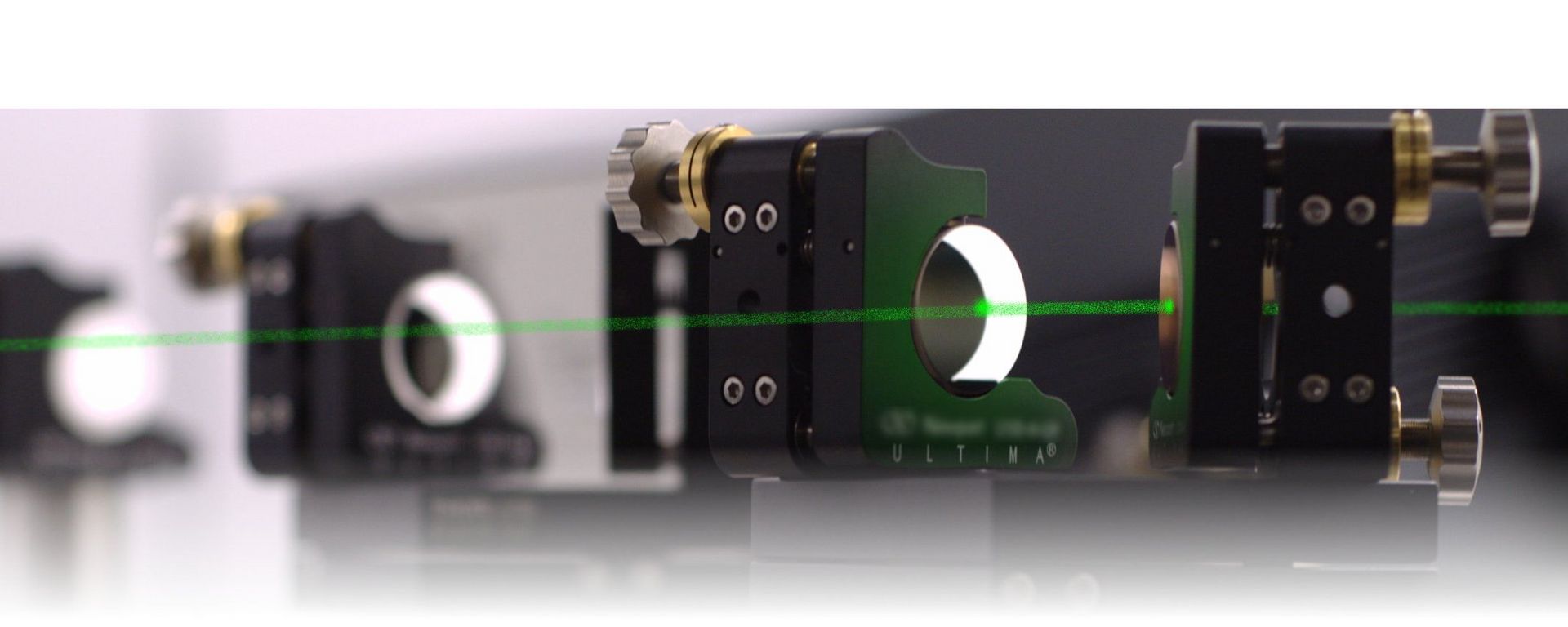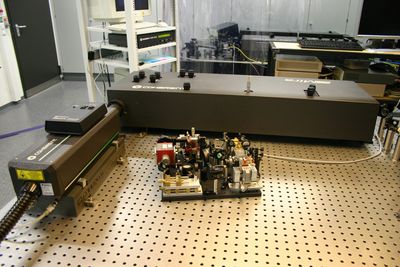Ultrashort pulse generation
Semiconductor lasers are a key technology in the telecommunications sector. The feature of direct electrically pumping allows for a fast modulation of the laser in combination with a very compact setup. However, in other areas like ultrashort pulse generation the breakthrough of semiconductor lasers is yet to come despite of their enormous advantages. Table 1 shows a comparison between solid state, fibre and semiconductor lasers. It can be seen that the current semiconductor laser date compare to the other lasers badly in the most relevant points like pulse duration and average output power. The aim of this research project is to close the gap between commercially available laser systems and semiconductor lasers to create an alternative, which has the potential to revolutionize the market for femtosecond laser systems.
Table 1: Comparison of femtosecond laser systems
| Solid state laser | Fiber laser | Semiconductor laser | |
| Min. pulse width | ++ | \+ | \- |
| Output power | ++ | \+ | \- |
| Flexibilityrepetition rate | \+ | 0 | ++ |
| Flexibilitywavelength | \+ | \- | ++ |
| Compactness | -- | \+ | ++ |
| Cost | -- | 0 | \+ |
Since the end of the 1980’s there is an intense ongoing research of semiconductor lasers as a source for ultrashort laser pulses. But the complex carrier dynamics in the semiconductor material doesn’t allow the direct generation of femtosecond pulses with high average output power from an electrically pumped semiconductor laser. Thus, we have developed a modular system concept as depicted in figure 1: in an oscillator based on a two section laser diode in an external cavity pulses with a duration of 5 ps are generated. The resonator geometry allows the compensation of the carrier dynamics in a fashion that the spectral bandwidth is greatly increased, while the pulse duration stays in the ps-regime.
This enables the amplification by an optical amplifier which is also an electrically pumped semiconductor device. In a second step the pulse is compressed by an external pulse compressor to some 100 fs. The usage of semiconductor devices enables the possibility to build the whole laser with a foot print as small as 300 * 300 mm². Figure 2 shows the compact femtosecond diode laser system in front of a commercial Ti:Sapphire laser system. All components to generate high power laser pulses are included.
The resonator internal dispersion control allows to generate pulses with a duration as short as 158 fs. These are to our knowledge the shortest pulses which were generated by an electrically pumped semiconductor laser. This closes the gap to fibre and solid state laser systems. After the pulse amplification pulse energies up to 2 nJ are generated. This leads to a peak power of 6.5 kW. Table 2 summarizes the specifications of the laser system. Table 3 is the modified version of table 1 with respect to our actual research results.
Table 2: Specifications of the prototype
Pulse energy: | 2 nJ |
Repetitions rate: | 300 kHz bis 1.2 GHz |
Min. pulse duration: | 160 fs |
Peak power: | 6.5 kW |
Central wavelength: | 850 nm |
Foot print: | 300 mm x 300 mm |
Table 3: Comparison of our fs-diode laser system to other femtosecond laser systems
| Solid state laser | Fiber laser | fs-diode laser | |
| Min. pulse width | ++ | /+ | /+ |
| Output power | ++ | /+ | /+ |
| Flexibilityrepetition rate | /+ | 0 | ++ |
| Flexibilitywavelength | /+ | /- | ++ |
| Compactness | -- | /+ | ++ |
| Cost | -- | 0 | /+ |
Based on our previous research we extended our system by investigating a multiple-pass amplification scheme instead of the single-pass one. This is performed by implementing the tapered amplifier in a adjustable ring cavity configuration. The amplifier is then seeded by an ultrashort pulse from a master oscillator. By matching the cavities geometrical lengths of master oscillator and ring amplifier, resonant pulse amplification regime is achieved. This project is funded by the DFG (Deutsche Forschungsgemeinschaft).
Reference:
- [1] M. A. Alloush, R. H. Pilny, C. Brenner, T. Prziwarka, A. Klehr, A. Knigge, G. Tränkle, M. R. Hofmann, “Mode-locked diode laser with resonant ring amplifier”, SPIE 10682, Semiconductor Lasers and Laser Dynamics VIII, 106820N (2018)
- [2] J. C. Balzer, T. Schlauch, A. Klehr, G. Erbert, G. Tränkle, M. R. Hofmann, “High peak power pulses from dispersion optimised modelocked semiconductor laser”, Electronics Letters, Volume: 49 , Issue: 13 (2013)
- [3] J. C. Balzer, T. Schlauch, A. Klehr, G. Erbert, M. R. Hofmann, “All semiconductor high power fs laser system with variable repetition rate”, SPIE 8277, Novel In-Plane Semiconductor Lasers XI, 827713 (2012)
- [4] J. C. Balzer, T. Schlauch, T. Hoffmann, A. Klehr, G. Erbert, M. R. Hofmann, “Modelocked semiconductor laser system with pulse picking for variable repetition rate”, Electronics Letters, Volume: 47, Issue: 25 (2011)
- [5] T. Schlauch, J. C. Balzer, A. Klehr, G. Erbert, G. Tränkle, and M. R. Hofmann, “Femtosecond passively modelocked diode laser with intracavity dispersion management”, Optics Express Vol. 18, Issue 23, pp. 24316-24324 (2010)
Colleagues:


